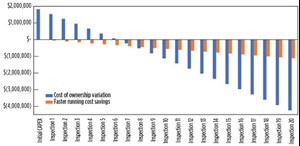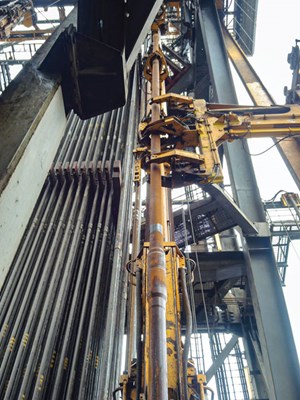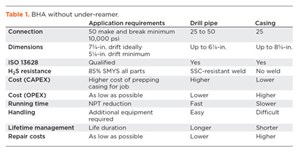Drill pipe-based completion workover risers lower costs and increase operational efficiency
The deepwater and ultra-deepwater sectors of offshore drilling have remained challenged through various market conditions. Volatility in pricing and an ongoing quest to increase cost efficiency has led to continued technical innovation, driven by the requirement to achieve higher breakeven prices typical of offshore developments. Using oil country tubular goods (OCTG) completion workover risers (CWORs) in deepwater projects has been cited as an alternative to drill pipe-based CWORs due to the inherent challenges of designing drill pipe connections that adhere to such rigorous environmental standards and difficult service conditions.
However, drill pipe has advanced technologically and is now a viable, cost-effective solution, in even the most challenging completion and intervention operations. While conventional OCTG solutions do provide some upfront cost benefit, drill pipe-based CWORs show significantly reduced total cost of ownership over the life of the product.
CWOR SPECIFICATIONS
CWORs are critical items used offshore as conduits from the subsea tree upper connection to a floating vessel on the surface of the water. This system of jointed tubulars allows for the safe installation/recovery of subsea vertical tree plugs (VXTs) and the passage of wireline tools or coiled tubing into the wellbore during workover operations of limited duration. Workover operations are normally performed in open water for VXTs but can also be performed inside a drilling riser, provided sufficient barrier elements are available. This means they must be able to withstand challenging environmental forces like ocean currents and heave.
The American Petroleum Institute’s (API) Recommended Practice (RP) 17G is the industry’s latest proposed standard used to define the functional requirements for components comprising the riser system and detailed requirements for riser pipe and connector design. ISO 13628-7 is the API RP 17G counterpart.
DRILL PIPE-BASED CWOR DESIGN
Historically, casing strings have served as the main tool for the CWOR market. The need for the large drift diameters necessary to remove subsea wellhead crown plugs and pass completion or workover tools made it impossible to run rotary-shouldered connection-based tubulars. While these casing-based systems have their advantages, they also have certain inherent limitations that have prompted operators to explore alternative solutions. With the advent of API RP 17G, these applications require:
- Larger ID drift diameters to accommodate the latest wellhead designs; up to 6-in. for the latest vertical subsea trees.
- Corrosion resistance if H2S is present.
- Higher working pressures (up to 20,000 psi internal pressure).
The development of large-diameter pipe; gas-tight rotary-shouldered connections incorporating metal-to-metal radial seals; sulfide stress cracking (SSC)-resistant welds; and high-strength, sour service metallurgy enabled drill pipe-based tubular use for these applications, Fig. 1.
DRILL PIPE-BASED CWOR TESTING
To ensure flawless performance in the field, drill pipe-based CWOR is subjected to rigorous qualification testing, including:
- Fatigue test: Harmonic fatigue tests are conducted.
- Combined loading: Samples are exposed to cycles combining internal and external pressure, bending (up to 15°/100 ft), tension or compression and temperature.
- Make and break: Connections are made-up and broke-out between 25 to 50 times to verify that there are no leaks and no visual deformation. No galling or marks are allowed on the threads, shoulders, seals, or seal area.
Drill pipe-based risers may also go through full qualification to API RP17G/ISO 13628-7 or an interpretation of a specification 17G ballot draft.
COST OF OWNERSHIP
Casing-based CWOR products offer several benefits when compared to drill pipe-based CWOR systems, including lighter weights, larger drifts, and a lower initial capital expenditure. It is important to note, however, that unlike drill pipe, casing is not designed for recurring make and breaks. While drill pipe can be made up and broken out up to 50 times before needing to be recut, casing products typically max out at 10 make and break cycles. Drill pipe connections are more rugged and typically exhibit a 20% to 40% lower recut rate as compared to casing and can also be refaced, negating the need for a full recut. This means that the total overall cost of ownership of a casing-based CWOR is 70% more expensive than a drill pipe-based CWOR over the life of the product, Fig. 2.

This problem is compounded because most casing manufacturers are not proficient at dealing with used connections, nor do they offer rethreading of their products, which may make the process difficult and expensive. Inspections for used casing strings, especially when dealing with threads, are not nearly as clear-cut as for drill pipe. Drill pipe benefits from very detailed inspection criteria, as outlined in API RP7G-2 or other industry standards, such DS1 or NS1.
While there are numerous qualified inspection companies for drill pipe-based products, there are just a few companies that specialize in used casing. This means that inspecting used OCTG threads typically requires an OEM representative’s presence and participation. Such a service incurs fees, even though most representatives only have experience with new connections. And generally, there is little room in the OCTG sphere of expertise for wider inspection criteria.
The end user will be directly impacted by this, as most imperfections will not pass OEM inspection, and many joints will have to be sent to machine shops for repair—meaning casing strings often survive only one job before requiring thread recut or having their couplings replaced.
Repairing and managing couplings also has its own set of challenges. Couplings must be protected from weather, and their storage is space intensive. Once tubulars are returned for inspection, the damaged couplings must be un-bucked by a certified bucking company. The bucking company may occasionally be able to provide these services on-site, but often the joints must be transported to the bucking company’s location, which adds an extra step to an already lengthy inspection and repair process. Once all joints are repaired, and it’s time to buck the new couplings back on the casing, the entire process must be repeated.
Additionally, for those casing connections requiring swaging, all the internal plastic coating will have to be burned off and reapplied. This is never the case with drill pipe-based products. When a casing CWOR reaches a certain length after repeated recuts, the shorter length makes it difficult to handle on the rig and will require special pup joints to enable handling the tubulars on a rig.
For all these reasons, drill pipe has a technological advantage, and is an economically competitive solution for completions and interventions. Designed for repeated use and repair, drill pipe naturally lends itself to well service throughout the life of a given project.
RUNNING AND HANDLING
Rotary-shouldered connections are more robust and allow for a greater number of make and breaks before requiring repair, Table 1. They also trip 4 to 10 minutes faster per connection, and as a tool typically used by drilling contractors, they do not require a casing running crew or specialized equipment to deploy the string. This can reduce trip-time by five hours/run on a 7,500-ft string. A CWOR may be assembled in stands, be racked back, and utilize hidden time on double-activity rigs, then deployed using the standard rig equipment (elevator, slips, and iron roughneck).
The consideration of the overall cost of running casing versus drill pipe should include the relative ease of use of the latter. Since drill pipe can be run by the drilling rig crew, it does not require any additional special equipment to be run, giving operators the flexibility to move seamlessly between drilling and completion operations. Using a casing-based CWOR requires special crews, weight compensators, spider elevators, and special handling plugs for rotation. All this attention on running and handling means that casing may often take up to five times longer to run as compared to drill pipe. This means time and cost savings for rotary-shouldered connection-based products due to the elimination of the need for special tools and/or crews.
The advantages of running drill pipe-based CWOR can be negated if not run properly as per the manufacturer’s recommended running and handling practices. Before deployment, make sure that specific CWORs are used for the operation they are designed for, as well as properly cleaned, doped, and stored, to ensure longer overall string life.
CONCLUSION
While casing may offer certain advantages as a CWOR, they reach an economic breakeven limit in terms of total cost of ownership after six inspections compared to a rotary-shoulder connection-based CWOR. Additionally, this breakeven does not take into consideration the added financial benefits of easier rig handling and running.
Drill pipe-based CWORs cut expensive rig running time dramatically, and the durability and ruggedness of drill pipe connections means that a drill pipe joint will see more runs than an OCTG counterpart. The financial benefit of running drill pipe-based products can also be spread over more projects instead of limited applications. With decades of improvements regarding connection robustness and ease of use, drill pipe-based CWOR technology offers superior performance, allowing operators to increase their operational efficiency and decrease overall total cost of equipment ownership. In the current market environment, anything that helps operators maintain a healthy bottom line must be seriously considered. WO
- Subsea technology- Corrosion monitoring: From failure to success (February 2024)
- Driving MPD adoption with performance-enhancing technologies (January 2024)
- X80 heavy wall pipe solutions for deep/ultra-deepwater field developments in mild sour environment (November 2023)
- FluiDeep: An innovative subsea storage and injection solution for chemicals management (November 2023)
- Wellbore seal control and monitoring enhance deepwater MPD operations (October 2023)
- Simplifying testing on subsea umbilical installation campaigns (August 2023)
- Applying ultra-deep LWD resistivity technology successfully in a SAGD operation (May 2019)
- Adoption of wireless intelligent completions advances (May 2019)
- Majors double down as takeaway crunch eases (April 2019)
- What’s new in well logging and formation evaluation (April 2019)
- Qualification of a 20,000-psi subsea BOP: A collaborative approach (February 2019)
- ConocoPhillips’ Greg Leveille sees rapid trajectory of technical advancement continuing (February 2019)




